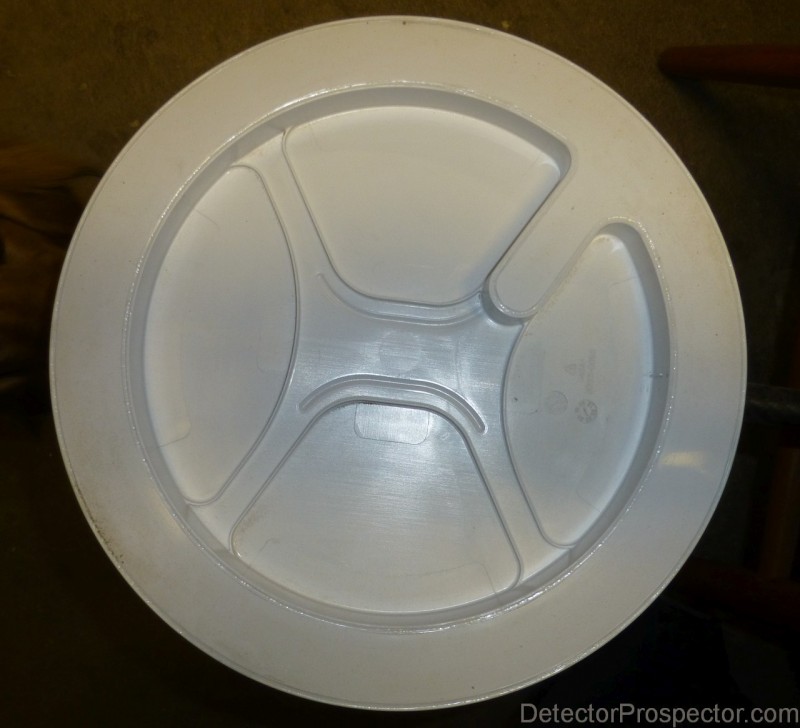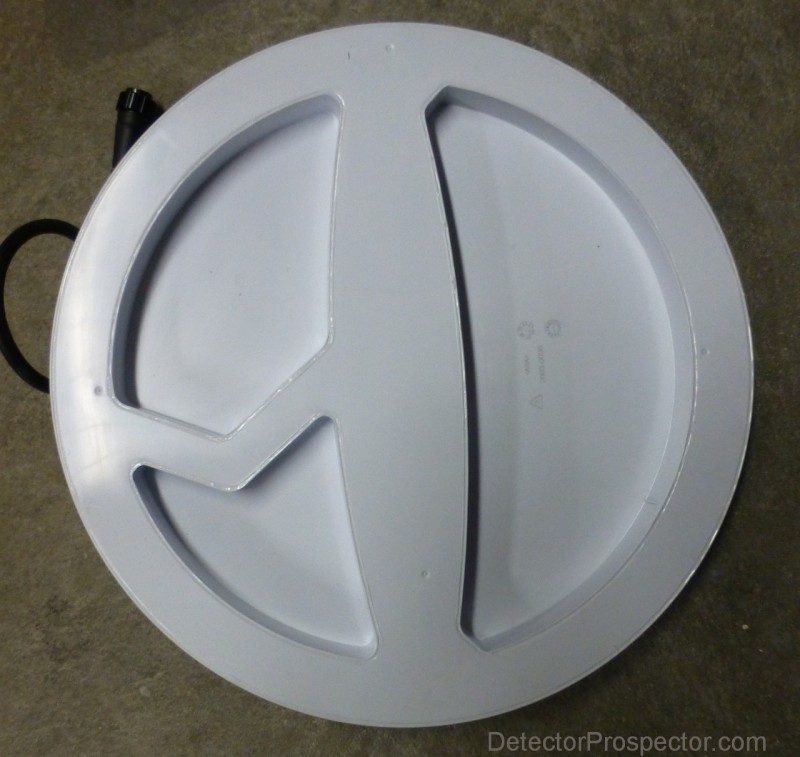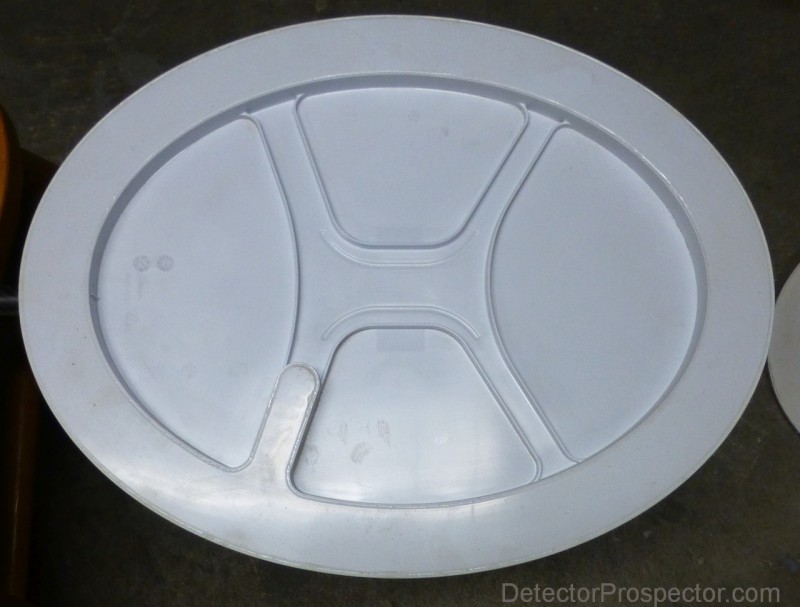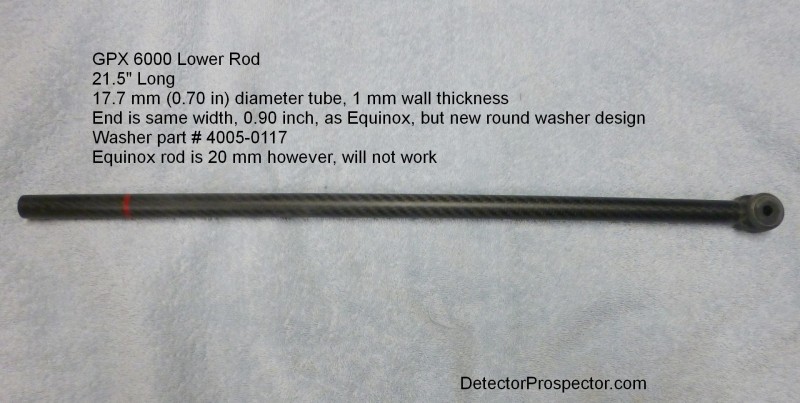-
Posts
19,803 -
Joined
Content Type
Forums
Detector Prospector Home
Detector Database
Downloads
Everything posted by Steve Herschbach
-

Gold Bug 2 And 6.5" Elliptical Coil
Steve Herschbach replied to Jerry Perez's topic in Metal Detector Advice & Comparisons
in the middle. You can test that for yourself, and should. -

Report From A 6000 Tester, Plus A Cover Kit
Steve Herschbach replied to Steve Herschbach's topic in Detector Prospector Forum
Nenad got a deep target signal, so decided to test the various sensitivity settings. Also see how targets sound with and without an audible Threshold in the Auto options. And maybe a late "surprise" as well. -
More on coils. The tops are just to shed debris and attach to detector. GPX11 mono, exactly 11" diameter, 562 grams coil and cable only (no scuff cover or coil bolt) Minelab GPX11 mono coil underside GPX14 DD, exactly 14" diameter, 892 grams coil and cable only Minelab GPX14 coil underside GPX17 mono, exactly 17" x 13", 802 grams coil and cable only Minelab GPX17 coil underside GPX 6000 lower rod 21.5" long, 17.7 mm (0.70 in) diameter tube, 1 mm wall thickness, end 0.90 in width, round washer part# 4005-0117 I've suggested to steveg that a 24" rod would be a nice option. Have to take care of the tall people! Minelab GPX 6000 Data & Reviews Minelab GPX 6000 Accessories and Spare Parts Minelab GPX 6000 Owner’s Manual
-
It could be all the difference in the world. You could save years of wasted time, and for a lot of people, if success does not come soon, they quit. Training helps stop that from happening. No mater how much you study, no matter how many videos you watch, nothing beats having an experienced person show you real live gold digs in the field. Most people are passing nuggets every trip, and simply not hearing them. It's a very subtle business, and easily one of the hardest types of detecting you can undertake. Finding that first nugget without help can be quite daunting. Yet I find gold every trip. That is the disparity of results we are talking about. So yes, do get training if at all possible. Best money you will spend.
-
Minelab is smart about coming up with ideas and patenting them well in advance, even for stuff they may never do. It costs a lot of money, but it does act to block the competition. White's wanted wireless data exchange for the V3 series, but Minelab saw far enough ahead to have patented that already, so they shut White's down on it. A lot of this looks like a basket full of ideas that Minelab can now claim as theirs only. What comes of any of it, who knows. Remote detecting on Mars? Might be a genuine application. https://www.detectorprospector.com/forums/topic/15738-gold-on-mars/ Heads up display with all previous mapped finds overplayed on your field of vision, how cool would that be for gold prospecting? A map overlay showing fault lines just by looking around? Could be amazing.
-
I did notice the 6000 finding birdshot or snake shot in areas I know other detectors flat out missed. Is that a good thing? I think so, but it’s a be careful what you wish for result, more sensitivity = more bird shot?
-

GPX 6000 All I Want To Know Is
Steve Herschbach replied to Condor's topic in Detector Prospector Forum
What you guys will find with testing is the results bleed seamlessly between the various models, with each having some edge the other lacks. This is the part that maddens people and makes simple answers dangerous. A Gold Monster still is best for finding invisible gold. If you have to own one detector, you will compromise, period. I promise anyone as a person that does the tiny gold thing, that if you get a 1/10th grain speck and do your tests, in actual ground, it will take a microscope and a micrometer and a lot of hours to sort out. For some people the Gold Monster will back up the GPX 6000 for the tiniest gold, and for discrimination. In my case, an Equinox with 6" coil will always be out with the 6000, which will often have the 17" mono running. Equinox is a pinpointer, trash handler, and flyspeck detector that pairs really well with the 6000. But for gold only guys, a shortened up Monster will be a better alternative. -

Glaciers & Gold
Steve Herschbach replied to Steve Herschbach's topic in Rocks, Minerals, Gems & Geology
Spent most of my life where ice was a mile thick, and nearly all the gold I’ve ever found was related to glacial action. Most glacial action is more recent than the massive ice sheets, with most small Alaskan glaciers being Pleistocene age, for example. Nobody not interested should waste their time in glacial terrain. I’m just the opposite. I’ll run a detector over anything just to see. I’ll never forget a patch I walked past for a decade because “gold can’t be there”, until a novice who was not as smart as I dug there and found out there was. Glacial terrain can be exciting as gold can literally be anywhere or nowhere. Glaciers also bury and preserve pre-glacial placer that can be very rich. Crow Creek Mine near Anchorage is a perfect example. -

GPX 6000 All I Want To Know Is
Steve Herschbach replied to Condor's topic in Detector Prospector Forum
Been bulldozing a lot with the 11” mono. Get a speck nearer the winding, bang! And yes, in the right ground little invisible hot rocks will make it impossible, but here at least I’m good. Guys here will love it, but gimme that 6x10 scrubber also please. -

GPX 6000 All I Want To Know Is
Steve Herschbach replied to Condor's topic in Detector Prospector Forum
I don’t see how anyone could not like it, just swinging it and listening to it. Yeah, I know, wear headphones... except I don’t anymore. The speaker is so loud it literally vibrates the speaker grill at full volume No harness, no bungee, no headphones... you may not find gold, but you’ll be comfortable doing it! -

GPX 6000 All I Want To Know Is
Steve Herschbach replied to Condor's topic in Detector Prospector Forum
Let’s just say we have different ground. I recommend high mineral, big gold people lean to JP, low mineral, small gold folks to me. Our observations and recommendations will be different. Any doubt, see Steve’s Insane GPZ Setting. I’m not saying you will never need DD coil, but I’m also saying a 6000 with 11” mono handles my salt ground better than a GPZ with stock coil. Is that because the coil is smaller? Of course. Does not change the fact that out of box, I’d rather run a 6000 with 11” mono in salt than a GPZ with stock coil. On my ground, the GPZ with stock coil acts more like the 6000 with 17” mono. The DD is not because the 6000 is inherently worse at salt or EMI, but that if either of those things stop what you have now.... it won’t stop a 6000. Yes, there is a performance hit, but if what you are doing is failing 100%, then it’s better than that. That’s the whole point. You never put the DD on unless it will help you, not hurt you. You will know when that is because you will want to toss detector in ditch. With 6000, put on DD, problem solved. But no problem, no DD coil. -

GPX 6000 All I Want To Know Is
Steve Herschbach replied to Condor's topic in Detector Prospector Forum
Not for me, been scrubbing the heck out of the 11” coil, going to need lots of scuff covers. So funny you say that... I’d say just the opposite for what I’m doing. Just goes to show why people are needed in different areas with different focus. And 11” mono handles salt so well, way better than GPZ, that the DD will be for truly worst case scenarios here... and the beach! JP and I hunt different ground, and I’m half nuts, so my Nevada recommendations will tend to be “hot” compared to JPs. I’m running the 6000 like it’s a Gold Bug 2, already lobbying for smaller “scrubber coil!” -

GPX 6000 All I Want To Know Is
Steve Herschbach replied to Condor's topic in Detector Prospector Forum
This was the most secretive project yet. Picture Steve crouched in bottom of ditch with prototype wrapped in garbage bag because a car came up. The protos spent most of their time in garbage bags, for fear a telephoto might see something. The actual shape was a big secret, no photos, don’t be seen.... adds a little extra challenge to nugget detecting. I am however, a lousy poker player, so no worries there! -

GPX 6000 All I Want To Know Is
Steve Herschbach replied to Condor's topic in Detector Prospector Forum
Trash is easier than gold so far this morning good showing already though so no worries, will finish out day, be home very late. I just wanted to note that fact production unit was delivered to my doorstep means dealer units are not far behind, probably on the way right now. -

GPX 6000 All I Want To Know Is
Steve Herschbach replied to Condor's topic in Detector Prospector Forum
I’m was on the GPX 6000 development crew. This is my first production level model, a step up from my last prototype... which I thought was great. Sadly for some out there, this means I have a 17” mono while the rest of you wait, but being a tester does have a few benefits. You folks that already own Minelab PI type tech... good for you, be happy! However, if you are a VLF hunter and been hanging back on the PI thing.... if you can afford it, now is the time to take the dive. Very powerful, very ergonomic, very easy to operate. Only caveats, no disc, and price. Otherwise, this is the machine you’ve been waiting for. GPZ 7000 is too deep a plunge, this is just right for a lot of folks. Says GPX 6000 fan number one, so just ignore me. I was Equinox fan number 1 for a reason, and this completes my set. GPX 6000 plus Equinox 800 equals nugget hunting bliss. A Monster might hit a hair smaller than my Equinox, but it’s close. The GPZ will hit a one pound nugget deeper... but I’ve had my shot there, not worried about it after 50 years of detecting. My Equinox 6000 is tops, that’s my story, and I’m sticking with it. Not worries about going toe to toe with GPZ operators in Nevada at all, as if you add it all up, salt, shallow small gold, it’s a genuine push as to which is the better choice. -

Official Minelab GPX 6000 Page
Steve Herschbach replied to Steve Herschbach's topic in Detector Prospector Forum
I find a “news release” a little hilarious at this point. Yeah, real news.... months after the Africans announced it! -

GPX 6000 All I Want To Know Is
Steve Herschbach replied to Condor's topic in Detector Prospector Forum
I think JP summed it up nicely. Yeah, 6000 gives Monster run for the money, but I still bet on Monster for the tiniest bits. Yeah, the 6000 gives the 7000 a run for the money, but I still bet on the GPZ for the deepest bits. For me 6000 is SDC that should have been, in regular box, with swappable coils. And better ability to obtain a smooth threshold while retaining power. SDC is more compact, fully submersible, less expensive, and will kill hot rocks that will bother 6000. But for me there is no comparison. Maybe an SDC owner that has Coiltek coils, but not really. That’s an aftermarket kludge, and looks it. So you could say the 6000 is like an SDC done up like a normal detector. But for me in my mind it’s “GPZ Lite” as the 6000 audio responses largely mirror GPZ responses as far as hot rocks and salt, though the 6000 handles salt way better. But anyone used to a GPZ will find 6000 familiar, just easier and smoother. It’s all very straight forward, with the only calculus here one to be made by people weighing 6000 vs 7000. For the power users, it will come up GPZ or GPZ plus 6000! For people like me.... 6000 all the way. I’m enough older than JP that our paths have now parted ways. Power guys are more in JP camp, I’m more in retiree camp, slowing down, and the GPX 6000 was made for me. Perfect detector at perfect time of my life. It’s 6000 + Equinox for me, 100% covered for anything. 6000 first, Equinox for trash and the tiniest bits (also gives Monster a run for the money there). All I can say is I let the 7000 go when 6000 entered radar, have not regretted it yet. In fact after yesterday, I’m happier than ever. Just spent a day digging Nevada nuggets, my shiny new GPX 6000 is no longer a gold virgin! Dig some more today.... report soon. I think I’m ungagged -

GPX 6000 All I Want To Know Is
Steve Herschbach replied to Condor's topic in Detector Prospector Forum
Minelab have made clear that the GPZ 7000 is the top dog, especially for larger, deeper gold. I would expect vey few serious operators to ever take a step down, as the drive is always "more power, more power." JP already made it clear the GPZ is and will continue to be his main machine. Long story short it will not be a market dump for the 7000. This is not a deal where everyone is upgrading to what is being sold as a more powerful replacement for the GPZ. Most power users will stay with what they have, or maybe add a 6000. I think this is aimed at people who have a SDC 2300 or GPX 4500/5000 etc. type detectors, but for whom the GPZ 7000 was too much weight and too much money. GPZ 7000 owners are last on the potential customer list I would think. The ones that are considering the 6000 are probably more in my camp. Willing to give up the chance of hitting a one pound nugget at three feet. Guess I'll only dig mine at 2.5 feet. The 6000 targets the bread and butter around here. I'll not worry about the big one going beep if I get over it. I'm the target customer, not JP. So which are you? -

Is This Red Obsidian?
Steve Herschbach replied to mrm0rgan's topic in Rocks, Minerals, Gems & Geology
Looks artificial to me, not obsidian. Pretty though. -
They will work, just not low latency - bummer.
-

Jamming Metal Detector Use
Steve Herschbach replied to WhiteRabbit's topic in Metal Detector Advice & Comparisons
Concealed same cameras do wonders. Nobody should ever assume they are not being seen these days. -

Jamming Metal Detector Use
Steve Herschbach replied to WhiteRabbit's topic in Metal Detector Advice & Comparisons
Certainly possible, but difficult. All detectors operate on a frequency, and a transmitter running at the same frequency will jam it. But there are many machines running at different frequencies, and they have ability to adjust in a range. Option one would be a shotgun transmitter putting out a broad spectrum signal to jam all the range of frequencies detectors operate at. I can't imagine this working in the city as you would be jamming more than detectors, but maybe on a ranch in the middle of nowhere. You could also use a frequency scanner to locate a detector in use within range, and then have the jammer work only against that frequency, so much more targets. Still no idea on the legalities, but technically it should be possible. Cost effective? I have no clue. Simple example. Turn on a Minelab GPX 5000 in the middle of a field. Nobody will be able to get within 50 feet of that machine with another detector, as the GPX is basically throwing off it's own portable jamming field. So there is an at least 100 foot diameter circle that been effectively jammed. Expanding the concept for range is the problem though, as power requirements escalate rapidly. Kind of related. It is possible to block cell signals. It is also illegal in many places. Police jammers, same deal. Jamming is as much a legal issue as anything, and I'd cross that bridge first, before worrying about the tech aspect. -

Official Minelab GPX 6000 Page
Steve Herschbach replied to Steve Herschbach's topic in Detector Prospector Forum
Yes! This!! 100% I did pretty well with the GPZ 7000 with 19” coil. I also, despite harness and bungee, after days of use, felt my shoulder go “boink” and that was that. And now, no more of “that!” I've got zero issue admitting I'm not the tough young buck I used to be, and taking it easier with what I have left is key to keeping the game going for me. The youngsters do not quite get it, but plenty of you know what I'm talking about. -

Official Minelab GPX 6000 Page
Steve Herschbach replied to Steve Herschbach's topic in Detector Prospector Forum
You are not bringing me down at all Jason, and I never claimed you gave me any flak. Your questions are entirely reasonable, as are people’s desires to get what they perceive as totally unbiased reporting. What that means is you are the better candidate than I to be doing a bunch of critical comparative performance testing. I’ve already told you what I think, and don’t have anything to add at this time. The problem with honesty is it does not deliver the black and white answers people crave. Reality is a bit more of a bummer, in that nuance and gray areas rule. Everyone has their own set of needs, and different machines match those needs differently for different people. I’m willing to ditch the GPZ 7000 for the GPX 6000, and JP is not. Why? JP pays bills with gold, and in his opinion the GPZ 7000 is what he has to use as a primary machine. Other machines like the 6000 are secondary for him. That seems equivalent to your situation. Me, I made the move from paying bills with gold, to being a casual detectorist. So I’m more in the boat with a different crowd than you. That’s the basis for my opinion, but it’s nothing more than that... my opinion. Some people I’ve just told them they should get a GPX 6000, no worries. You are a more serious operator, as are many here, and I’m not going to assume I know your business better than you do yourself. In my opinion, if everyone would just read all the Minelab info, including the star chart, and accept that it is all ballpark accurate, a lot of this fuss could be avoided. Some of the star chart positioning does involve intangibles, like will easier learning make for better operators. It simply is what they say it is, no big mystery, but like everything when you try to be simplistic, a little wiggle room is left on the table. From what I’ve seen, Minelab has nailed the positioning here very well, below GPZ 7000 but above the rest. But do not beat me up if somebody finds gold with a Gold Monster that a 6000 will not see, $900 versus $6000. That could happen, so does that make the Monster the better machine? Maybe, for some people, especially those with small gold and a ton of trash. In a trash pit, the Monster operator could wipe the street with the 6000 owner. The world is not black and white, and almost every machine has a tiny area that it really excels at, where others are weak. As far as Geosense, we know the GPX 6000 has far fewer settings than the GPX 5000, yet it claims better performance across the board. People say that can't be done with fewer controls. What if the machine was reading the ground and adjusting the timings for you, instead of requiring you to somehow know what the ground and gold is like before you've even started? I'll never claim I really know how Geosense works, but it should be obvious that it is this feature that allows for so many settings to be removed. Part of our thinking on how to choose a proper 5000 timing has been built into the 6000, so we do not have to make that choice. With the 5000 odds are casual operators are not tuned for optimum performance. This is hard to do with the 6000... you'd actually have to purposefully misadjust it. -
As a guy with glasses and hearing aids... I like! I may order a prescription set as polarized sunglasses, could be great for wading work as well as the desert.




